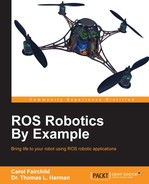With the ability to speak, your robot can take on a personality of its own. There are multiple styles of voices available for your robot, and its ability to carry on a conversation is only limited by your imagination.
The two current methods of providing the capability for your robot to speak are analogous to the speech recognition abilities mentioned in the previous section. The ROS package sound_play (from the audio-common metapackage) offers one method and the Rospeex software provides another.
The ROS package sound_play supports playing built-in sound files, OGG and WAV files, and processing speech synthesis data produced via Festival. Festival is a text-to-speech (TTS) ability developed by the University of Edinburgh. Multiple languages are supported through this project and the companion Festvox project at CMU. More information on these speech synthesis projects can be found at:
The sound_play package provides the ROS node sound_play (in soundplay_node.py) to translate commands on the ROS topic robotsound. API bindings in C++ or Python allow this node to be used independent of the details of the sound message format. The play_sound package say.py script can be used from the terminal command line to input a text string or from standard input. The details of its usage can be found at http://wiki.ros.org/sound_play.
It is important to check out the package dependencies listed in the readme file at https://github.com/ros-drivers/audio_common/tree/master/sound_play.
It is also important to work through the tutorials to set up your Ubuntu sound drivers and USB speaker system to play sounds and speech. The three tutorials for setting up and creating the sound_play interface are found at http://wiki.ros.org/sound_play/Tutorials.
The Rospeex software described in the previous section also enables your robot to speak. Its website provides an example of a talking clock to highlight the capabilities of this software. Speech synthesis is available for Japanese, English, Chinese, and Korean languages. By using its APIs in Python or C++, a sample function for a simple spoken dialogue can be written in as little as 10 lines.
Next, we will progress to making it possible for your robot to recognize faces if it is equipped with a vision sensor like a RGB or USB camera.
